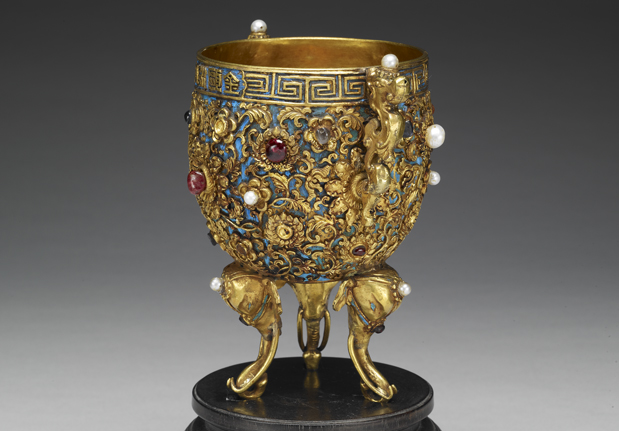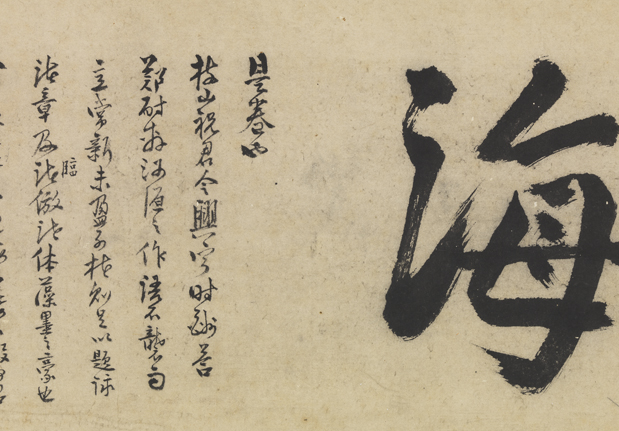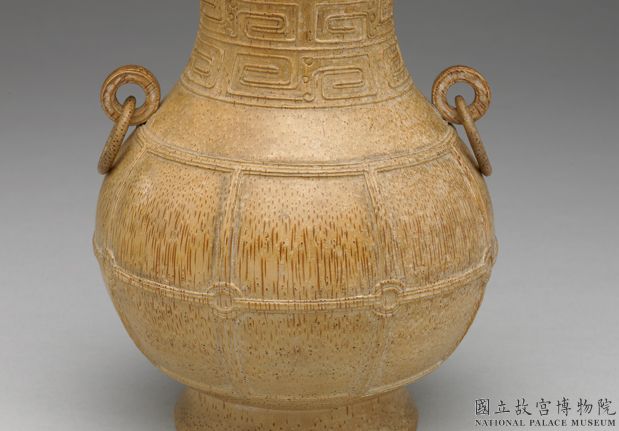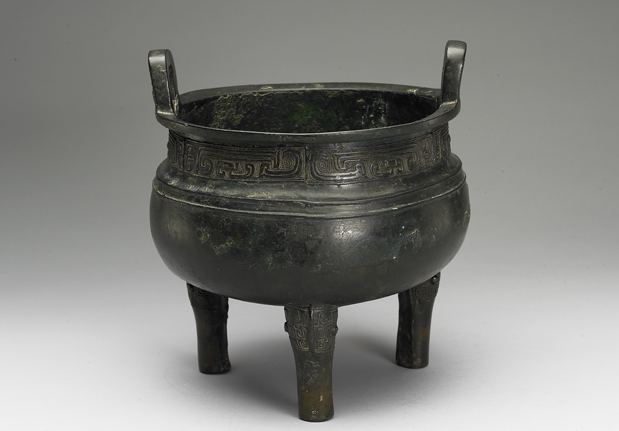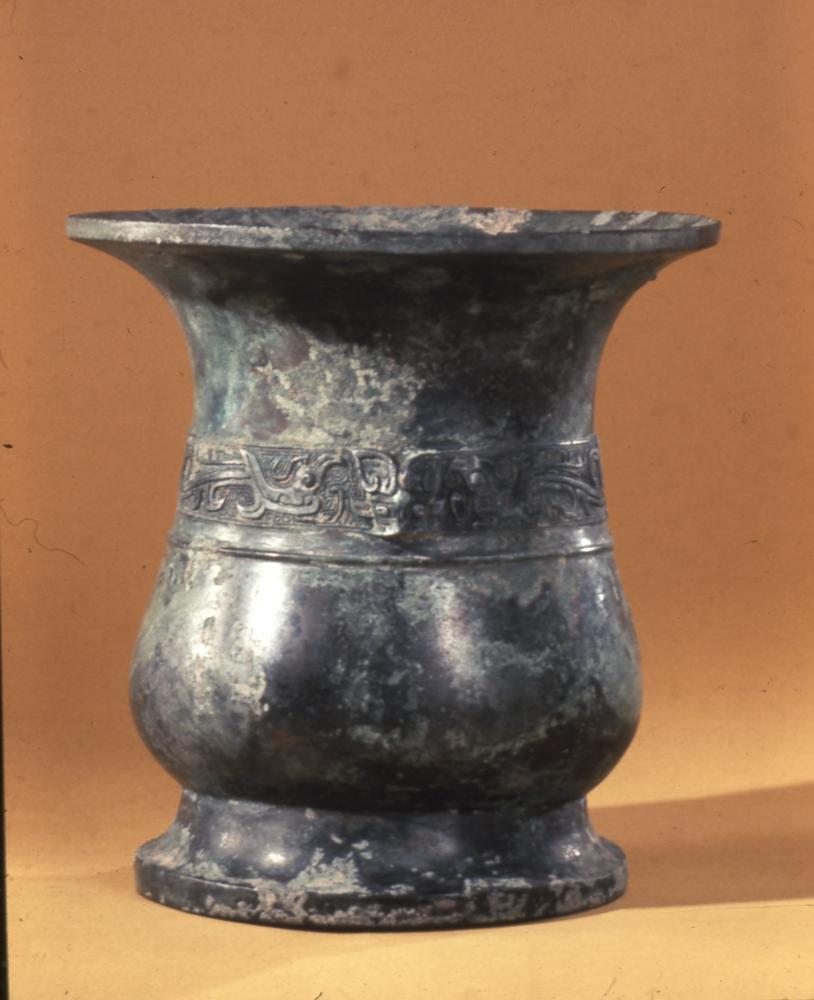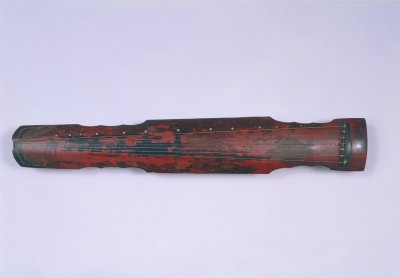Period:Unknown Production date:1783
Materials:paper
Technique:engraving, etching,
Subjects:prisoner ceremony/ritual arch/gateway
Dimensions:Height: 266 millimetres Width: 427 millimetres
Description:
Plate I: the Qianlong Emperor is presented with prisoners taken during the East Turkestan campaign; scene at the Wumen (Meridian Gate), the southern gate of the Imperial Palace in Peking in 1760; to right, in an open gallery forming part of a pavilion at the top of the gate, the Emperor and attendants watch the scene in the courtyard below; here, three groups of men kneel on a pathway facing the gate, one man holding up a bag with the head of Khoja Jihīn (in Chinese Huojizhan) known as the Younger Khoja; with imperial bodyguards and figures playing music, in attendance. 1783 Etching and engraving Reduced version of Plate 14 in original set: Presentation [to the Emperor] of the prisoners from the pacification of the Muslim tribes (On offre [à l’Empereur] les prisonniers [faits lors] de la pacification des tribus musulmanes)
IMG
![图片[1]-print; album BM-1877-0714.1505-China Archive](https://chinaarchive.net/Unknown/43/mid_PPA69359a.jpg)
![图片[2]-print; album BM-1877-0714.1505-China Archive](https://chinaarchive.net/Unknown/43/mid_PPA69359.jpg)
Comments:This set consists of twenty four prints in the form of an album bound in red paper-covered boards. Sixteen of the prints are reduced copies of the prints in the original set ‘Conquêtes de l’Empereur de la Chine’ which were engraved under the direction of Cochin. Helman produced these reduced versions from 1783 to 1785, and they were published in 1785 in four livraisons of four plates each by Helman and Ponce. Soon afterwards, in 1786, Helman added four further prints to the set, representing two additional subjects, one of an agricultural ceremony led by the Emperor and another (in three plates) of a procession by the Emperor in Peking. These were published by Helman and Ponce. In 1788, Helman added a further four prints to the set, bringing the total number of engravings to twenty-four, all included in this album.However, the identification and description of the events and scenes lettered in the sixteen Helman prints corresponding to Cochin’s set is unreliable, because most of the the plate numbers (and therefore the plate sequence) do not correspond to those established by Pelliot for the Cochin set. Pelliot provided a concordance for the plates in both sets, which has been used in the literature thereafter.The album includes a printed sheet with a summary of the original imperial ‘Conquêtes’ commission, and a list of the contents of the Helman album itself. This list, in the form of a table, provides descriptions of the scenes depicted (as lettered on the individual prints). In addition, for the first sixteen plates, corresponding to those in Cochin’s set, the original producer names are also provided (ie. Cochin’s name, that of the engraver and usually that of the original draughtsmen).A description is provided for Plate XVII, but no producer names. Plates XVIII, XIX and XX have a joint entry, with an indication that they were intended to be ‘assembled’ to form one scene, and with the names and addresses of Helman and Ponce.There is another Helman album (with only twenty prints and no printed list of contents) in the Department of Asia (Registration Number OA+, 0.7423.1 to 18).See Paul Pelliot, Paul Pelliot, ‘Les Conquêtes de l’Empereur de la Chine’, T’oung Pao, vol.XX, 1921, 183-274; Michèle Pirazzoli-t’Serstevens, ‘Gravures des Conquêtes de l’Empereur de la Chine K’ien-long au Musée Guimet’, 1969.See also Joanna Waley-Cohen, ‘Commemorating War in Eighteenth-Century China’, Modern Asian Studies, Vol. 30, no.4, Special Issue: War in Modern China (Oct. 1996), pp. 869-899.
Materials:paper
Technique:engraving, etching,
Subjects:prisoner ceremony/ritual arch/gateway
Dimensions:Height: 266 millimetres Width: 427 millimetres
Description:
Plate I: the Qianlong Emperor is presented with prisoners taken during the East Turkestan campaign; scene at the Wumen (Meridian Gate), the southern gate of the Imperial Palace in Peking in 1760; to right, in an open gallery forming part of a pavilion at the top of the gate, the Emperor and attendants watch the scene in the courtyard below; here, three groups of men kneel on a pathway facing the gate, one man holding up a bag with the head of Khoja Jihīn (in Chinese Huojizhan) known as the Younger Khoja; with imperial bodyguards and figures playing music, in attendance. 1783 Etching and engraving Reduced version of Plate 14 in original set: Presentation [to the Emperor] of the prisoners from the pacification of the Muslim tribes (On offre [à l’Empereur] les prisonniers [faits lors] de la pacification des tribus musulmanes)
IMG
![图片[1]-print; album BM-1877-0714.1505-China Archive](https://chinaarchive.net/Unknown/43/mid_PPA69359a.jpg)
![图片[2]-print; album BM-1877-0714.1505-China Archive](https://chinaarchive.net/Unknown/43/mid_PPA69359.jpg)
Comments:This set consists of twenty four prints in the form of an album bound in red paper-covered boards. Sixteen of the prints are reduced copies of the prints in the original set ‘Conquêtes de l’Empereur de la Chine’ which were engraved under the direction of Cochin. Helman produced these reduced versions from 1783 to 1785, and they were published in 1785 in four livraisons of four plates each by Helman and Ponce. Soon afterwards, in 1786, Helman added four further prints to the set, representing two additional subjects, one of an agricultural ceremony led by the Emperor and another (in three plates) of a procession by the Emperor in Peking. These were published by Helman and Ponce. In 1788, Helman added a further four prints to the set, bringing the total number of engravings to twenty-four, all included in this album.However, the identification and description of the events and scenes lettered in the sixteen Helman prints corresponding to Cochin’s set is unreliable, because most of the the plate numbers (and therefore the plate sequence) do not correspond to those established by Pelliot for the Cochin set. Pelliot provided a concordance for the plates in both sets, which has been used in the literature thereafter.The album includes a printed sheet with a summary of the original imperial ‘Conquêtes’ commission, and a list of the contents of the Helman album itself. This list, in the form of a table, provides descriptions of the scenes depicted (as lettered on the individual prints). In addition, for the first sixteen plates, corresponding to those in Cochin’s set, the original producer names are also provided (ie. Cochin’s name, that of the engraver and usually that of the original draughtsmen).A description is provided for Plate XVII, but no producer names. Plates XVIII, XIX and XX have a joint entry, with an indication that they were intended to be ‘assembled’ to form one scene, and with the names and addresses of Helman and Ponce.There is another Helman album (with only twenty prints and no printed list of contents) in the Department of Asia (Registration Number OA+, 0.7423.1 to 18).See Paul Pelliot, Paul Pelliot, ‘Les Conquêtes de l’Empereur de la Chine’, T’oung Pao, vol.XX, 1921, 183-274; Michèle Pirazzoli-t’Serstevens, ‘Gravures des Conquêtes de l’Empereur de la Chine K’ien-long au Musée Guimet’, 1969.See also Joanna Waley-Cohen, ‘Commemorating War in Eighteenth-Century China’, Modern Asian Studies, Vol. 30, no.4, Special Issue: War in Modern China (Oct. 1996), pp. 869-899.
© Copyright
The copyright of the article belongs to the author, please keep the original link for reprinting.
THE END
